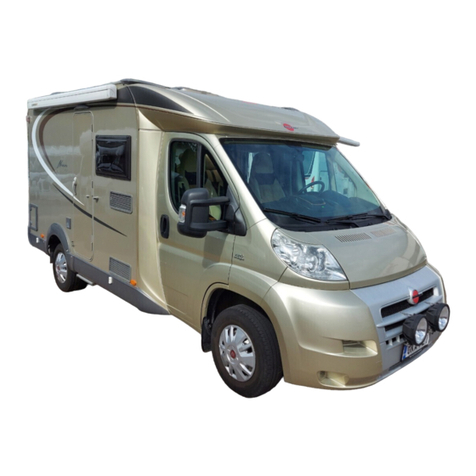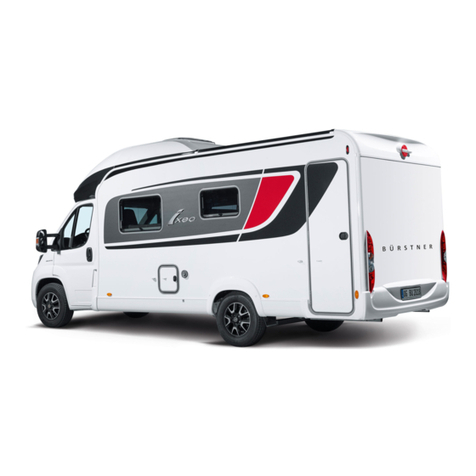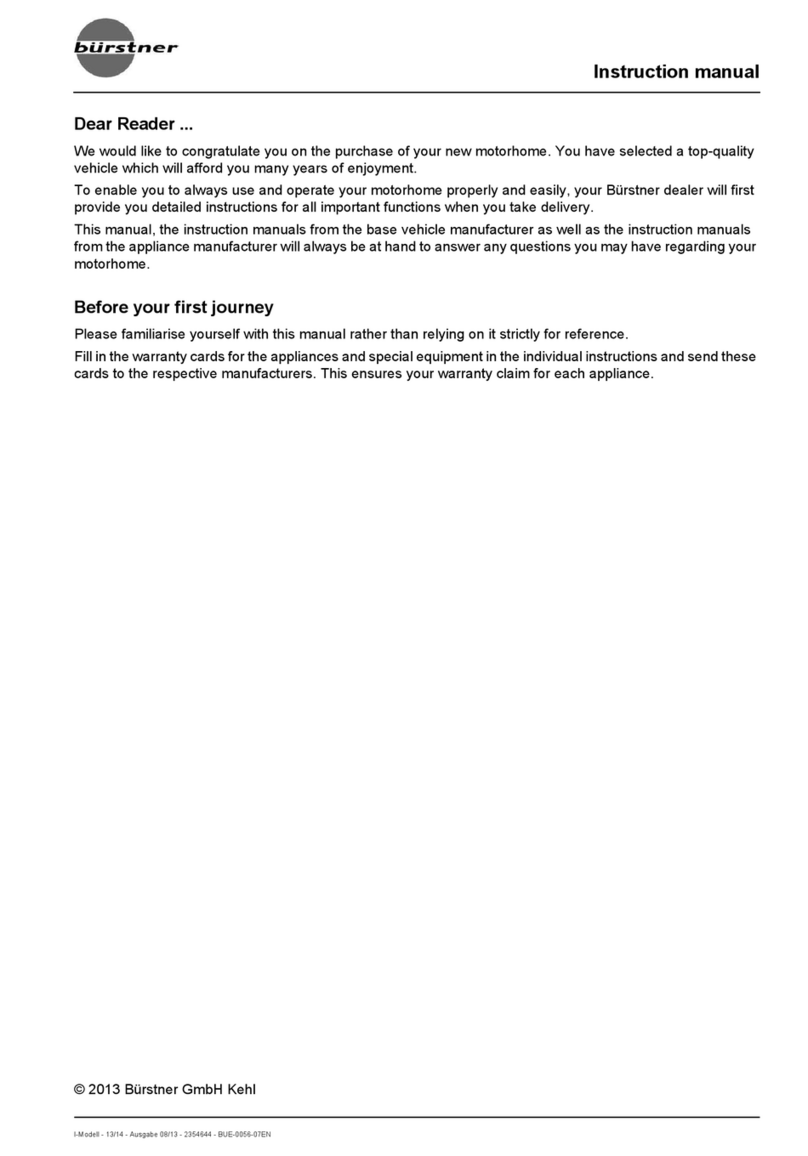
ontents
I-Modell - 07/07 - Ausgabe 03/07 - 1512317 - BUE-0056-00E
6.2.5 Cap for the fresh water filler neck . . . . 54
6.3 Furniture flaps . . . . . . . . . . . . . . . . . . . 54
6.3.1 Furniture flaps with snap fastener . . . . 55
6.3.2 Furniture flaps with handle and push
button. . . . . . . . . . . . . . . . . . . . . . . . . . 55
6.4 Light switch . . . . . . . . . . . . . . . . . . . . . 56
6.4.1 Entrance area . . . . . . . . . . . . . . . . . . . 56
6.4.2 Interior . . . . . . . . . . . . . . . . . . . . . . . . . 56
6.5 Spotlight. . . . . . . . . . . . . . . . . . . . . . . . 57
6.6 Holder for flat screen . . . . . . . . . . . . . . 58
6.7 Ventilation . . . . . . . . . . . . . . . . . . . . . . 59
6.8 Windows . . . . . . . . . . . . . . . . . . . . . . . 59
6.8.1 Hinged window with automatic
hinges . . . . . . . . . . . . . . . . . . . . . . . . . 60
6.8.2 Sliding window without lock . . . . . . . . . 61
6.8.3 Blind and insect screen (variant 1). . . . 62
6.8.4 Roman shade and insect screen
(variant 2). . . . . . . . . . . . . . . . . . . . . . . 62
6.8.5 Roman shades for windscreen,
driver's window and front
passenger's window. . . . . . . . . . . . . . . 64
6.9 Skylights. . . . . . . . . . . . . . . . . . . . . . . . 64
6.9.1 Hinged skylight. . . . . . . . . . . . . . . . . . . 65
6.9.2 Wind-up skylight. . . . . . . . . . . . . . . . . . 66
6.10 Tables . . . . . . . . . . . . . . . . . . . . . . . . . 67
6.10.1 Suspension table with separable
support leg. . . . . . . . . . . . . . . . . . . . . . 67
6.10.2 Suspension table with changeable
table leg . . . . . . . . . . . . . . . . . . . . . . . . 67
6.10.3 Fixed table (extendable table-top) . . . . 69
6.10.4 Lift-off table of the L-seating group . . . 69
6.11 Beds. . . . . . . . . . . . . . . . . . . . . . . . . . . 70
6.11.1 Pull-down bed . . . . . . . . . . . . . . . . . . . 70
6.11.2 Fixed bed. . . . . . . . . . . . . . . . . . . . . . . 71
6.12 Converting seating groups for
sleeping . . . . . . . . . . . . . . . . . . . . . . . . 72
6.12.1 Central bench with divan (narrow) . . . . 72
6.12.2 Front bench seat (guest bed). . . . . . . . 73
7 Gas system. . . . . . . . . . . . . . . . . . . 75
7.1 General . . . . . . . . . . . . . . . . . . . . . . . . 75
7.2 Gas bottles. . . . . . . . . . . . . . . . . . . . . . 76
7.3 Changing gas bottles . . . . . . . . . . . . . . 77
7.4 Gas isolator taps . . . . . . . . . . . . . . . . . 78
7.5 External gas connection
(special equipment) . . . . . . . . . . . . . . . 78
7.6 Duomatic switching facility
(special equipment) . . . . . . . . . . . . . . . 79
7.7 Level indicator (special equipment) . . . 80
8 Electrical system . . . . . . . . . . . . . 83
8.1 General safety instructions . . . . . . . . . 83
8.2 Terms. . . . . . . . . . . . . . . . . . . . . . . . . . 83
8.3 12 V power supply . . . . . . . . . . . . . . . . 84
8.3.1 Starter battery . . . . . . . . . . . . . . . . . . . 84
8.3.2 Living area battery . . . . . . . . . . . . . . . . 85
8.4 Transformer/rectifier (EBL 99) . . . . . . . 86
8.4.1 Battery cut-off switch . . . . . . . . . . . . . .88
8.4.2 Battery selector switch . . . . . . . . . . . . .88
8.4.3 Battery monitor . . . . . . . . . . . . . . . . . . .88
8.4.4 Charging the battery. . . . . . . . . . . . . . .89
8.5 Panel (IT 994). . . . . . . . . . . . . . . . . . . .89
8.5.1 V/tank gauge for battery voltage
and water or waste water levels . . . . . .89
8.5.2 Battery alarm for the living area
battery. . . . . . . . . . . . . . . . . . . . . . . . . .91
8.5.3 Digital clock/temperature gauge. . . . . .91
8.5.4 Current gauge for charging/
discharging the living area battery . . . .92
8.5.5 12 V main switch . . . . . . . . . . . . . . . . .93
8.5.6 12 V indicator lamp. . . . . . . . . . . . . . . .93
8.5.7 230 V indicator lamp. . . . . . . . . . . . . . .93
8.5.8 Switch for water pump . . . . . . . . . . . . .93
8.6 Panel (DT 220) . . . . . . . . . . . . . . . . . . .94
8.6.1 12 V main switch . . . . . . . . . . . . . . . . .94
8.6.2 LCD display . . . . . . . . . . . . . . . . . . . . .95
8.6.3 Basic menu. . . . . . . . . . . . . . . . . . . . . .95
8.6.4 Battery menu . . . . . . . . . . . . . . . . . . . .96
8.6.5 Battery alarm for the living area
battery. . . . . . . . . . . . . . . . . . . . . . . . . .97
8.6.6 Battery capacity alarm for the
living area battery. . . . . . . . . . . . . . . . .98
8.6.7 Battery defect message for living
area battery . . . . . . . . . . . . . . . . . . . . .98
8.6.8 Tank menu . . . . . . . . . . . . . . . . . . . . . .98
8.6.9 Tank alarm . . . . . . . . . . . . . . . . . . . . . .98
8.7 Solar installation
(special equipment) . . . . . . . . . . . . . . .99
8.8 230 V power supply . . . . . . . . . . . . . .100
8.8.1 230 V connection . . . . . . . . . . . . . . . .100
8.8.2 Power cable for external
230 V connection . . . . . . . . . . . . . . . .100
8.9 Fuses . . . . . . . . . . . . . . . . . . . . . . . . .101
8.9.1 12 V fuses. . . . . . . . . . . . . . . . . . . . . .101
8.9.2 230 V fuse . . . . . . . . . . . . . . . . . . . . .104
8.10 External socket
(special equipment) . . . . . . . . . . . . . .105
8.11 Circuit diagrams . . . . . . . . . . . . . . . . .106
8.11.1 Circuit diagrams, interior . . . . . . . . . .106
8.11.2 Circuit diagram, exterior . . . . . . . . . . .110
9 Appliances. . . . . . . . . . . . . . . . . . .111
9.1 General. . . . . . . . . . . . . . . . . . . . . . . .111
9.2 Heater. . . . . . . . . . . . . . . . . . . . . . . . .112
9.2.1 Models with waste gas vent on the
right-hand side of the vehicle . . . . . . .112
9.2.2 To heat properly . . . . . . . . . . . . . . . . .112
9.2.3 Trumatic C hot-air heater . . . . . . . . . .113
9.2.4 Alde hot-water heater
(special equipment) . . . . . . . . . . . . . .115
9.2.5 Auxiliary heat exchanger
(partially special equipment). . . . . . . .118
9.2.6 Electrical floor warming unit
(special equipment) . . . . . . . . . . . . . .118

































